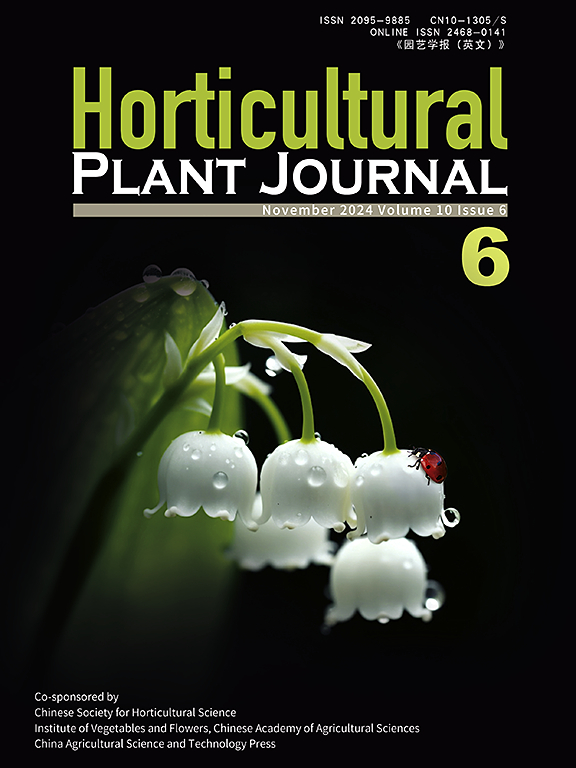菠菜中草酸盐含量的基因组学研究:全基因组关联研究和基因组预测方法
IF 5.7
1区 农林科学
Q1 HORTICULTURE
引用次数: 0
摘要
菠菜中的草酸盐含量与人类健康息息相关,是人们关注的一个重要性状。了解其遗传基础有助于开发草酸盐含量更低的菠菜品种。为了了解其遗传决定因素,一个由 288 个菠菜品种组成的多样化小组对草酸盐含量进行了全面的表型分析,并对其进行了全基因组重测序,从而获得了一个包含 14 386 个单核苷酸多态性(SNPs)的综合数据集。利用该数据集,我们进行了一项全基因组关联研究(GWAS),以确定与草酸盐含量相关的值得注意的 SNPs。此外,我们还利用五个 GP 模型,通过交叉预测(GP)来评估草酸盐含量的基因组估计育种值(GEBV)。观察到的正态分布和超过 600.0 毫克 - 100 克-1 的草酸盐含量的广泛范围突出了这一性状的复杂性和定量性,它可能受到多个基因的影响。此外,我们的分析还发现了明显的分层现象,将人群划分为四个明显的亚群。此外,利用 GAPIT 3 和 TASSEL 5 中的五个模型进行的 GWAS 分析揭示了与草酸盐含量相关的九个显著 SNP(四个 SNP 位于 1 号染色体,五个位于 5 号染色体)。这些位点与六个候选基因相关,这些基因可能对草酸盐含量的调节有潜在贡献。值得注意的是,我们的 GP 模型具有显著的预测能力,对 GEBV 估计的平均准确率高达 0.51。GWAS 和 GP 方法的整合提供了对菠菜中草酸盐含量遗传基础的整体理解。这些发现为开发草酸盐含量最优化的菠菜栽培品种和杂交种提供了一个前景广阔的途径,从而促进了消费者的健康。本文章由计算机程序翻译,如有差异,请以英文原文为准。
Genomic insights into oxalate content in spinach: A genome-wide association study and genomic prediction approach
Oxalate content in spinach is a key trait of interest due to its relevance to human health. Understanding the genetic basis of it can facilitate the development of spinach varieties with reduced oxalate levels. In pursuit of understanding the genetic determinants, a diverse panel comprising 288 spinach accessions underwent thorough phenotyping of oxalate content and were subjected to whole-genome resequencing, resulting in a comprehensive dataset encompassing 14 386 single-nucleotide polymorphisms (SNPs). Leveraging this dataset, we conducted a genome-wide association study (GWAS) to identify noteworthy SNPs associated with oxalate content. Furthermore, we employed genomic prediction (GP) via cross-prediction, utilizing five GP models, to assess genomic estimated breeding values (GEBVs) for oxalate content. The observed normal distribution and the wide range of oxalate content, exceeding 600.0 mg · 100 g−1 , underscore the complex and quantitative nature of this trait, likely influenced by multiple genes. Additionally, our analysis revealed distinct stratification, delineating the population into four discernible subpopulations. Furthermore, GWAS analysis employing five models in GAPIT 3 and TASSEL 5 unveiled nine significant SNPs (four SNPs on chromosome 1 and five on chromosome 5) associated with oxalate content. These loci exhibited associations with six candidate genes, which might have potential contribution to oxalate content regulation. Remarkably, our GP models exhibited notable predictive abilities, yielding average accuracies of up to 0.51 for GEBV estimation. The integration of GWAS and GP approaches offers a holistic comprehension of the genetic underpinnings of oxalate content in spinach. These findings offered a promising avenue for the development of spinach cultivars and hybrids optimized for oxalate levels, promoting consumer health.
求助全文
通过发布文献求助,成功后即可免费获取论文全文。
去求助
来源期刊

Horticultural Plant Journal
Environmental Science-Ecology
CiteScore
9.60
自引率
14.00%
发文量
293
审稿时长
33 weeks
期刊介绍:
Horticultural Plant Journal (HPJ) is an OPEN ACCESS international journal. HPJ publishes research related to all horticultural plants, including fruits, vegetables, ornamental plants, tea plants, and medicinal plants, etc. The journal covers all aspects of horticultural crop sciences, including germplasm resources, genetics and breeding, tillage and cultivation, physiology and biochemistry, ecology, genomics, biotechnology, plant protection, postharvest processing, etc. Article types include Original research papers, Reviews, and Short communications.
 求助内容:
求助内容: 应助结果提醒方式:
应助结果提醒方式:


